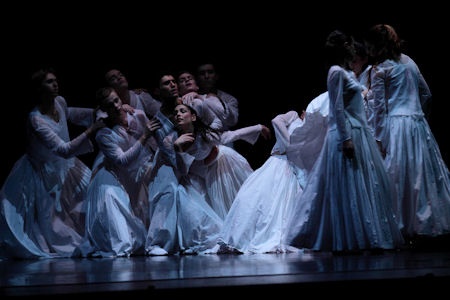Stravinsky Selection - Royal NZ Ballet
Civic Theatre, 88 Tay Street, Invercargill, Invercargill
08/06/2011 - 09/06/2011
Aotea Centre at THE EDGE®, Auckland
25/05/2011 - 28/05/2011
St James Theatre 2, Wellington
20/05/2011 - 22/05/2011
Production Details
Striking a balance between dance tradition and modern innovation, the set list shows the company’s versatility and inspiring energy.
Petrouchka: A lavish and lively restaging of the 1911 masterpiece Petrouchka takes pride of place in the programme. Set in the colourful world of a Russian fairground, the much-loved ballet follows a doomed love triangle between puppets: the tragic clown Petrouchka, the witless ballerina doll he loves, and the alpha male Moor. Sir Jon Trimmer appears as the puppet master – but the real person pulling the strings behind the scenes is the legendary choreographer Russell Kerr, who ensures this centenary production stays true to its grand heritage.
Satisfied with Great Success: Radiating mystery and beauty, Satisfied with Great Success gives modern immediacy to classical ballet. Making its debut this season, the work is choreographed by one of the most exciting new talents in international dance, expat Kiwi Cameron McMillan, and features costumes by renowned designer Karen Walker. Taking his cue from the ravishing score, McMillan’s ballet unfolds in a series of electrically-charged scenes played out before 50-year-old film footage of Stravinsky in New Zealand.
Milagros: With an air of dangerous intent, Javier De Frutos’ Milagros puts a match to the composer’s most incendiary ballet score, The Rite of Spring. Created for the Royal New Zealand Ballet in 2003, the work’s ferocious imagination and mesmerising drama earned it major international awards attention. Sacrifice everything to see this landmark ballet.
Petrouchka: Music Igor Stravinsky, Petrouchka | Design Raymond Boyce after Alexandre Benois | Lighting Nigel Percy.
Lead dancers: Qi Huan (The Moor), Tonia Looker (The Ballerina Doll), Medhi Angot (Petrouchka)
Satisfied with Great Success: Music Igor Stravinsky, Scènes de Ballet | Design Karen Walker | Lighting Nigel Percy
Lead dancers: Lucy Green and Medhi Angot
Milagros: Music Igor Stravinsky, The Rite of Spring | Design Javier de Frutos | Lighting Nigel Percy
2hr 25min (with 2 intermissions)
Two tough acts for poor Petrouchka to follow
Review by Bernadette Rae 27th May 2011
Read the full review: http://www.nzherald.co.nz/entertainment/news/article.cfm?c_id=1501119&objectid=10728233
Triple bills are the best – and another innovation of choreographer Diaghilev and composer Stravinsky, in the Ballet Russes. The Royal New Zealand Ballet’s celebration of Stravinsky’s music, including Diaghilev’s short ballet Petrouchka, again celebrates the form in an intense and explorative programme.
First up is the primal and confronting Milagros, by Javier De Frutos, in the company’s repertoire for eight years and still as riveting a Rite of Spring as ever. Pagan Russia is suggested in riffs of Cossack-style moves, but the costumes are unisex swirlings of white, the dancers curiously labelled by number patches on their backs.
Copyright © in the review belongs to the reviewer
Satisfied with Great Success is the delight in this Triple Bill
Review by Raewyn Whyte 26th May 2011
Copyright © in the review belongs to the reviewer
Comments
Helen Wenley May 28th, 2011
I watched this production last night. I am not a ballet fan. However I was blown away by the fluidness and precision of all the dancers. It is a spectacular and enjoyable production.
Make a comment
You must be logged in to post a comment.
Stravinsky commands the evening
Review by Greer Robertson 21st May 2011
Copyright © in the review belongs to the reviewer
Comments
Make a comment
You must be logged in to post a comment.
Make a comment
You must be logged in to post a comment.







Comments